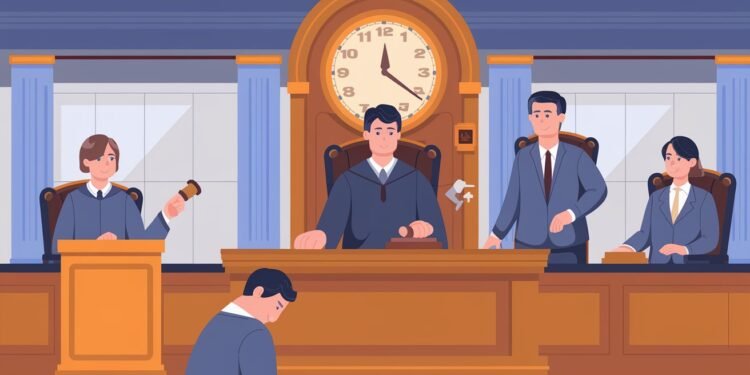K. Sai Saketh, Svkm’s Narsee Monjee Institute of Management Studies, Bengaluru.
Facts of the Case
On the nighttime of the incident, Rishidev Pandey, his brother Ram Lochan Pandey, and their associate Banslochan had been involved in the homicide of a man named Sheomurat. The activities spread out inside the village in which the victim was napping on a cot. Eyewitnesses testified that Rishidev and Ram Lochan had been seen standing close to the cot, with Ram Lochan armed with a ‘gandasa’ (a form of conventional weapon) and Rishidev conserving a ‘lathi’ (a timber stick). Banslochan turned into positioned close to the door, acting as a lookout. As the night progressed, Ram Lochan lifted the ‘gandasa’ and inflicted a deadly blow to Sheomurat’s neck. This blow was stated to be an incised wound, which medical evidence later confirmed as necessarily fatal. Notably, there have been no symptoms of any blows from the ‘lathi’ at the sufferer, indicating that Rishidev did now not directly take part within the act of homicide. Upon hearing the commotion and cries for assistance, both Rishidev and Ram Lochan fled the scene collectively, leaving Banslochan at the back of. The brothers absconded right away after the incident but surrendered to the government. They have been subjected to court cases under Sections 87 and 88 of the Criminal Procedure Code (CrPC) for his or her absence. Following the investigation, the Sessions Judge convicted all 3 guys beneath Section 3021 of the Indian Penal Code (IPC) for murder, together with Section 342, which relates to acts executed in furtherance of not unusual aim. Each of them acquired a demise sentence, pending confirmation through the High Court. While Ram Lochan and Banslochan ordinary their sentences and did not attraction, Rishidev contested the ruling, leading to the existing attraction.
Procedural history:
Initial Proceedings The case began when Rishidev Pandey, his brother Ram Lochan Pandey, and their associate Banslochan had been charged with the murder of Sheomurat. The Sessions Court conducted a trial in which the prosecution supplied evidence, including eyewitness bills, that established the involvement of all 3 accused in the homicide. The Sessions Judge found them guilty under Section 302 of the IPC, which relates to murder, and Section 34, which addresses
1 Section 302 of the Indian Penal Code 1860
2 Section 34 of The Indian Penal Code 1860
acts completed in furtherance of not unusual intention. The trial court docket sentenced all three to death, considering the gravity of the crime.
High Court Appeal
Following their conviction, the 3 accused appealed to the High Court. However, Ram Lochan and Banslochan did now not contest their sentences and usual the death penalty. The High Court, consequently, focused its evaluation on Rishidev Pandey’s attraction. The court examined the evidence, and the arguments offered regarding the unusual intention shared by some of the accused. The High Court upheld the conviction and the dying sentence for Rishidev, confirming that the presence of all 3 on the scene and their actions indicated a premeditated goal to kill.
Supreme Court Proceedings
Dissatisfied with the High Court’s selection, Rishidev Pandey appealed to the Supreme Court of India. The Supreme Court became tasked with reviewing the application of Section 34 of the IPC in this context. The bench, comprising Justices S. Das, Bhagwati, and J. Imam, analyzed whether Rishidev could be held answerable for homicide despite now turning in the fatal blow. The Supreme Court’s deliberation centered on the concept of not unusual intention, spotting that it can expand spontaneously at the scene of a criminal offense. The Court concluded that the actions of Rishidev and his brother demonstrated a shared intent to commit murder, even though only Ram Lochan had physically inflicted the fatal injury. The Court emphasized that all participants in a crime could be held equally responsible for the outcome if they acted with a common purpose.
Issue:
- Whether the accused individuals had the commonplace goal to homicide the deceased.: The number one query was whether or not Rishidev Pandey and his accomplices shared a common purpose to commit homicide. Section 34 of the IPC states that when a criminal act is done through several men and women in furtherance of a not unusual purpose, anyone is liable for the act as though he had achieved it himself. The Court needed to decide if the moves of Rishidev and his brother Ram Lochan indicated a premeditated plan to kill the victim, Sheomurat.
- Whether the 2 accused who were present alongside Ram Lochan, also are chargeable for committing murder.: The Court needed to confirm if the presence of Rishidev and
Banslochan at the scene of the crime, along with Ram Lochan’s armed reputation, constituted joint legal responsibility for the murder devoted by means of Ram Lochan. The defense argued that Rishidev ought to not be held responsible because he did now not inflict the fatal injury, even as the prosecution maintained that everyone 3 accused have been similarly culpable under the doctrine of common intention.
- Evidence of Participation: The Court examined the proof offered, which included eyewitness accounts of the incident. The testimony indicated that Rishidev turned into gift with a ‘lathi’ at the same time as Ram Lochan introduced the deadly blow with a ‘gandasa’. The prosecution argued that the mere presence of Rishidev and his movements for the duration of the crime had been enough to infer a shared intent to kill.
Arguments Advanced
Arguments by appellant: Arguments Advanced by the Appellant
- Non-Participation within the Fatal Act: Rishidev’s primary argument became that he did not for my part inflict the deadly blow that killed the victim, Sheomurat. He contended that his handiest brother, Ram Lochan, was responsible for the homicide, which changed into installed with the aid of the medical evidence indicating that the deadly injury turned into because of a ‘gandasa’ wielded by using Ram Lochan. Rishidev argued that his mere presence at the scene should no longer be construed as participation in the crime.
- Absence of Common Intention: The appellant argued that there was no hooked up not unusual goal most of the accused to devote murder. He maintained that the prosecution did not demonstrate that there was a prior settlement or shared purpose to kill Sheomurat. Rishidev contended that the incident may also have come about spontaneously, with no premeditated plan to dedicate murder.
- Credibility of Eyewitness Testimony: Rishidev’s defense challenged the reliability of the eyewitnesses who testified in opposition to him. The protection argued that the debts furnished by the witnesses have been inconsistent and lacked credibility, hence failing to establish a clean narrative of shared intent for a few of the accused.
- Legal Interpretation of Common Intention: The appellant’s counsel argued in opposition to the application of Section 34 of the IPC, which relates to common aim. Rishidev’s protection claimed that the prosecution did not accurately prove that he had a commonplace goal with Ram Lochan and Banslochan to commit homicide. They argued
that an unusual aim requires a previous assembly of minds, which was now not obvious in this case.
- Individual Liability: Rishidev’s defense emphasized that each accused should be judged based on their individual actions rather than being collectively liable for the actions of one individual. The argument was that since Rishidev did not commit the act of murder, he should not be held liable under the principle of joint liability.
Arguments by respondent:
- Establishment of Common Intention: The respondent argued that there has been clear evidence of a common goal for many of the accused. Despite Rishidev now not turning in the deadly blow, his presence on the scene, alongside along with his brother Ram Lochan, who was armed with a ‘gandasa’, indicated a shared rationale to dedicate homicide. The prosecution maintained that the moves of all 3 accused have been coordinated and aimed at executing the murderer.
- Joint Liability Under Section 34: The respondent emphasized that Section 34 of the IPC holds all contributors in a criminal offense similarly chargeable for the moves taken in furtherance of a commonplace goal. The prosecution argued that on the grounds that Ram Lochan inflicted the fatal blow, all 3 accused, together with Rishidev, have been accountable for murder as they acted together with a not unusual motive.
- Eyewitness Testimony: The respondent depended on the testimony of eyewitnesses who located the events main to the homicide. The witnesses confirmed that Rishidev become present on the scene and that each he and Ram Lochan fled together after the assault. This corroborated the prosecution’s declaration that Rishidev became complicit within the crime.
- Nature of the Attack: The respondent mentioned the brutal nature of the attack, arguing that it validated a premeditated rationale to kill. The truth that Ram Lochan turned into armed and the manner in which the assault became finished suggested that the accused had deliberate the homicide, in addition helping the argument for common purpose.
- Rejection of Defense Arguments: The respondent countered the appellant’s claims concerning the dearth of premeditation and the credibility of eyewitnesses. They argued that the proof supplied turned into sufficient to establish the guilt of Rishidev and that the defense did not provide compelling reasons to doubt the prosecution’s case.
- Implication of Presence: The respondent argued that mere presence at the scene of a crime, especially when armed, implicates an individual in the crime. They maintained that Rishidev’s presence with a ‘lathi’ and his actions during the incident were enough to infer his involvement and shared intent to commit murder.
Judgement
In the case of Rishidev Pandey v. State of U.P., AIR 1955 SC 331, the Supreme Court of India upheld the conviction of Rishidev Pandey and his brother Ram Lochan for the homicide of Sheomurat, maintaining their death sentences. The Court dominated that although Ram Lochan inflicted the deadly blow, the proof demonstrated a clear commonplace goal among the accused to commit homicide, as both were gift at the scene and acted in live performance. The Court emphasized the applicability of Section 34 of the Indian Penal Code (IPC), which holds individuals at the same time accountable for acts executed in furtherance of a common purpose. It clarified that commonplace aim may want to expand spontaneously for the duration of the commission of a crime, and the collective movements of the accused indicated a premeditated motive to kill. The Supreme Court brushed off the appellant’s arguments regarding his lack of direct involvement and the absence of premeditation, reinforcing the precept that each person involved in a criminal offense can be held equally culpable for its results. This judgment serves as an extensive precedent in Indian crook law regarding the translation of common purpose and joint liability.
Conclusion
The judgment in Rishidev Pandey v. State of U.P. Serves as a landmark case in Indian crook law, clarifying the criminal interpretations of not unusual goal and joint liability. It mounted that presence and participation in against the law, coupled with a shared cause, can lead to collective obligation for the movements taken at some stage in the commission of the crime.



